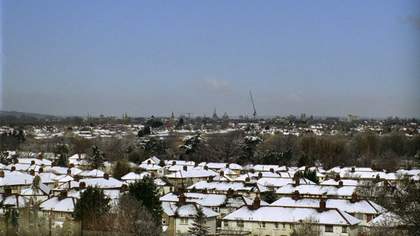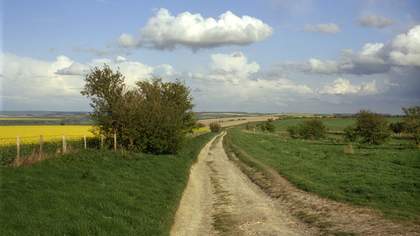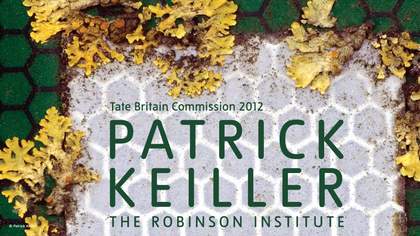The opening sentence of Patrick Keiller’s Robinson in Ruins 2010, voiced with laconic precision and italic irony by the actress Vanessa Redgrave, is calculated to quicken the hearts of admirers of Keiller’s enigmatic oeuvre: ‘When a man named Robinson was released from Edgecote open prison, he made his way to the nearest city and looked for somewhere to haunt.’ The film is the third of Keiller’s feature-length essay-fictions to deposit his eccentric protagonist among the relics of millennial England, where he functions once more as the comically half-deluded conduit for the director’s own brand of visionary scholarship. As a fictional invention, the autodidact aesthete Robinson, whom we only ever encounter via the films’ narrators’ vexed relations with him, is an absurd sort of wraith, tricked up from reminders of Daniel Defoe and Céline, but surely also a descendant of the Regency showman D.W. Robertson, inventor of the proto-cinematic phantasmagoria. In Robinson in Ruins, his spectral patch is the landscape around Keiller’s own home in Oxford: its industrial heritage, its residual romanticism, the weird energies of Englishness at a time of global economic collapse.

Fig.1
Oxford seen from Castle Car Park, Cowley in Patrick Keiller’s Robinson in Ruins 2010
Courtesy Patrick Keiller
Since the 1970s, Keiller has been architect, photographer, installation artist and, increasingly, an essayist of stylish rigour regarding urban planning, architectural decay and the vast culturally occluded material infrastructure that subtends daily life in Britain. But he remains best known for the first two Robinson films, London in 1994 and Robinson in Space three years later: films in which his tireless research into the structure of everyday life is parlayed into devious fiction, and the drear actualities of city and country yield surprisingly ravishing images. Keiller is a poet of blank statistics – in person, he can talk at length about patterns of land use in suburban Oxford or the hidden flourishing of Britain’s ports – and a connoisseur of built dullardry: nostalgic housing estates, defunct factories, centripetal supermarkets. But he is also a genuine, if ironised, seer; a follower of Walter Benjamin’s call for a ‘profane illumination’ of mundane existence.1 And as Robinson in Ruins attests again, he is an incisive, poised and frequently hilarious writer, contriver of a prose voice with no equals among contemporary British filmmakers and, in terms of intellectual range and mordant wit, few among recent novelists.2
Keiller was born in Blackpool in 1950. From the late 1960s, he studied at the Bartlett School of Architecture in London, and subsequently taught at the University of East London and many other institutions.3 In 1979 he began a postgraduate degree at the Royal College of Art, and it is from then that one can readily date the mature Keiller aesthetic. He began making films in the wake of austere structural experiments by the likes of Tony Conrad and Michael Snow in the US, and the rise in Britain of theorist practitioners such as Laura Mulvey and Victor Burgin. But if there was an English avant-garde in this period, it had lately turned to a kind of romantic conceptualism whose adherents were unafraid of elegance and a doleful native humour; the works of Peter Greenaway, John Smith and William Raban all had some affinities with Keiller’s. And in 1980, Chris Petit’s Radio On made the outskirts of London look as glamorously dismal as the cityscapes of Wim Wenders films of the previous decade or the earthbound portions of Andrei Tarkovsky’s Solaris 1972.
Keiller’s first films, however, were made at some deliberate remove from the work of these contemporaries. His background in architecture offers one partial explanation. In the late 1970s, he began noting instances of ‘found architecture’ from suburban train windows and cycling to the spot to photograph them, producing a wryly homegrown counterpart to the stark industrial anatomy photographed by the German artists Bernd and Hilla Becher. Stonebridge Park 1981, was the product of one such excursion. Visually, the film is composed of a few snaking handheld shots of a motorway bridge and a metal railway footbridge in north-west London. But the voice-over (Keiller’s own) recounts the mannered noir tale of a thief and would-be murderer whose rueful apologia (‘I began to be a little depressed’) situates the film somewhere between England at the end of the 1970s and a Europe of the mind, with its echoes of city visionaries from Charles Baudelaire through Louis Aragon to the Situationists and their vagrant dérives. Keiller’s second film, Norwood 1984, maintained the lugubrious narrative tone and visual deadpan; its monochrome suburban vistas are glum rehearsals of Camille Pissarro’s impressionist views of London in the 1870s. But it also suggested that behind the formal estrangements of his films lay a real anxiety about the decline of the city: after half a decade of Thatcherism, Norwood announces ‘the age of small business’ and notes that politically and socially speaking, ‘collectivity lies in ruins’.
The short black-and-white films of this period already hint, then, at the seamless amalgam of politics and poetry that makes the Robinson films so entrancing. With London and Robinson in Space, certain aspects of his work condensed – the somewhat antic plots of the early films had already given way in The Clouds 1989 to spacey travelogue, and the camera stopped moving so that the signature Keiller shot has ever since been a static linger that seems in its meditative way to last much longer than it does in fact. But Keiller’s first feature-length works also broach a new expansiveness and freedom; highly saturated colours allowed him to mine alike the comic and picturesque qualities of what he saw, be it an inflatable Ronald McDonald, a quasi-utopian Travelodge or a dark glistening clump of frogspawn. And the most striking, resonant feature of the films of the 1990s is the actor Paul Scofield’s interpretation of the off-screen narrative voice: a voice of exact and dreamy sarcasm, only slightly startled by the oddity of England and the extremity of Robinson’s responses to it.
Robinson and the narrator are ex-lovers, charged by mysterious funders with exploring London and its environs. What they discover is a country stunned into convention and nostalgia by a decade and a half of Conservative rule. Robinson, an aspirant (or possibly actual) continental sophisticate, despairs of the boredom and timidity of London – ‘a city under siege from a suburban government’ – and elects to repurpose its fading landmarks as monuments to Romantic literature. London is littered with expected references to William Wordsworth, Daniel Defoe and Horace Walpole, but Robinson’s surrealist eye turns Leicester Square into a monument to Laurence Sterne, the BT Tower into a homage to Paul Verlaine and Arthur Rimbaud, Brent Cross shopping centre (where he spies ‘a small intense man reading Walter Benjamin’) into a socio-cosmic wormhole that leads directly to the Parisian arcades of the nineteenth century. London was filmed at a time of precipitous economic crisis, IRA bombs in the City and the scarcely thinkable re-election of the Prime Minister John Major – in that context, Robinson’s wild visions of cultural renovation and Keiller’s melancholy framing of the extant ruins of the metropolitan ideal seem to make equal sense.
In a way, Robinson in Space was a strict textural continuation of London – here again was Scofield’s sly, bemused and creamy delivery; here too the sunny views of anonymous infrastructure and off-screen in the margins the slightly sordid Robinson, now reduced to teaching English in Reading. But Keiller had found a new subject: the unexamined vanishing of British industry into a hinterland of motorways, logistics sheds and huge ports that operated almost without staff. Robinson and his long-suffering companion were now employed to investigate ‘the problem of England’, which problem seemed initially to consist in the fact that lingering geopolitical power and recent economic recovery could not save the country from fatal nostalgia and decrepitude, resentment in the face of modernity and a generally ruinous attitude to culture and sex. In fact, what the increasingly mythical duo find out as they tour about in their Morris Oxford, loitering in Tesco and eyeing up fetishware factories, is that modernity has simply absconded: Britain is as industrious as ever, except that commerce and invention now happen in exurban non-places and scarcely touch the run-down or well heritaged cities.
Much of Keiller’s output since Robinson in Space has been concerned with the Blairite period of fervent and doomed hope regarding Britain’s potential urban modernity. In 2000 he made The Dilapidated Dwelling: a more conventional documentary (though still framed in fiction, and this time voiced by the actress Tilda Swinton) about the decline of British housing stock. The City of the Future, an interactive installation shown at the BFI in 2007, revealed through archive footage how little the fabric of Britain’s cities has altered since the invention of cinema. With Robinson in Ruins, Keiller embarks on a wider survey of the conundrum of the English landscape: the way the countryside has long been the seat of industry and infrastructural innovation, but is still culturally figured as natural, homely, picturesque. Some of Keiller’s thinking on this subject was nourished in academic collaboration with the geographer Doreen Massey and the cultural historian Patrick Wright, both of whom have written compellingly on the power structures that link city, country and global capital.
But its scholarly origins ought not to suggest that Robinson in Ruins is a drier undertaking than the first two films, with their scurrile attitude to the political classes and their hints at Robinson’s adventurous sex life. The eccentric and visionary wit is intact. In successive close-ups, a patch of lichen on an Oxford road sign comes to resemble the profile of Goethe. Robinson, at large among the relics of military-industrial technology, eventually settles on a disused cement works, crumbling into romantic ruin, as the potential site of a new utopian community. The history of clearances and land riots ghosts the new landscape of Private Finance Initiative follies, unpeopled agribusiness and the amnesiac transformation of every fraught patch of land (Greenham Common included) into a Site of Special Scientific Interest. All of this is rendered, meanwhile, with Keiller’s customarily austere but rapt visual style – though in this case, as suits a film partly about the persistence of pastoral in the face of rapacious land grabs, the shots are longer. The camera tarries with fields of oil seed rape, nodding foxgloves and shivering primroses until they start to look monstrous, every bit as alien as the relics of nineteenth century architecture and décor that so exercised the surrealists. Before Keiller’s (or Robinson’s) prophetic gaze, the English countryside is a monument to itself, and ripe for revolutionary appropriation.
Such an attitude places Robinson and his creator squarely, if vexedly, within the venerable tradition of the English enthusiasm for ruins. The film’s title does not just tell us as much, but tells us too that its director is wryly aware of the artistic, literary and filmic renaissance of ruin aesthetics, with all that follows in the way of potential for nostalgia or kitsch. Robinson, as we’ve seen, evinces a keen interest in ‘romantic ruins’. The history of English ruin aesthetics is of course in part the history of a certain properly Romantic forgetting or elision of the industrial reality of the countryside – one thinks immediately of William Wordsworth, perched above the vacant precincts of Tintern Abbey and entertaining thoughts of ‘deep seclusion’ where thoughts of woodland industry might be more appropriate: the ‘wreaths of smoke / Sent up, in silence’ more likely denoting charcoal production than the hearth of some lone hermit, the seemingly unaltered landscape in which the poet uncovers his adolescent self actually, as always, a fluxual territory fought over alike by industry and the countervailing impulse toward a picturesque Nature.
It is less easy, however, to dismiss the entire ruin aesthetic that took hold of European art and literature in the eighteenth century – and in which English writers, painters and architects played such a distinct and central role – as merely an exercise in blind nostalgia. For sure, as Keiller’s film reminds us, ‘ruin lust’ (as it came to be known in that century) is in part a fantasy, a way of reconfiguring the landscape as a collection of monuments, much in the way that Robinson remakes London as an array of memorials to more or less plausible European visitors. In fact the ruin, so carefully and knowingly invoked by Keiller, is as likely oriented to the future as to the past – hence Robinson’s conflation of the picturesque and the utopian in the 2010 film. We may think here of the paintings of Hubert Robert that first inspired Denis Diderot, in his Salon of 1767, to speak of the new aesthetic force of ruination – Robert had painted the Louvre as it might appear following some nameless future catastrophe – or Joseph Gandy’s paintings of the Bank of England in ruins, commissioned by Sir John Soane on its completion in the 1830s.4 Later in the century, London itself was the object of a future-directed ruin gaze, Thomas Babington Macaulay (and, inspired by Macaulay, Gustave Doré) picturing a future visitor from New Zealand drawn by the wreckage of St. Paul’s Cathedral to contemplate the end of empires. Towards the end of the century, Richard Jefferies’s novel After London (1885) conjured a vision of England reverting, after the end of civilisation, to a state of wilderness, and the metropolis itself to marshland.
In part, it is in this tradition of futuristic ruin that we have to place Keiller’s wryly complex engagement with the theme of decay and the attractions of desolation. Where much of the cultural turn to the imagery and thematics of ruination has (in the decades either side of the millennium) essentially trafficked in the historical frisson of seeing artefacts of the recent past reduced to fragments and relics – consider, for example, the prevalence of modernist ruins, with everything they invoke of the past century’s cultural radicalism or, in Britain, of a vanished post-war social-democratic consensus, in much contemporary art – Keiller’s films and other projects have consistently broached a more vexed and paradoxical temporality. His work is to be distinguished too from the broad resurgence of interest – ostensibly a sceptical interest, disabused of picturesque consolations – in the English landscape as a museum of cultural memory or repository of ruins of the recent past. The latter tendency is typified by the work of Iain Sinclair, for whom what is of interest in the exurban wastes of contemporary England is precisely what has been culturally submerged or (to deploy Sinclair’s own term) ‘reforgotten’ in the neo-liberal near-consensus of the past quarter-century. In the same vein (at least in terms of its chronological orientation) a certain reading of the novels of W.G. Sebald – and in particular his most avowedly ‘English’ book, Rings of Saturn, translated in 1998 – revisits and continues the melancholic or nostalgic strain in ruin aesthetics. And in terms of later work we might suborn a relatively mainstream volume such as Michael Symmons, Roberts and Paul Farley’s Edgelands (2011), an exploration of the ruderal and derelict spaces on the edges of urban England, to the same project.5 The adjacent field of the ‘new nature writing’ bears the traces of this tendency too, books such as Robert Macfarlane’s The Wild Places (2007) or Richard Mabey’s Weeds (2010) – Mabey might be said to have pioneered the genre in the 1970s with The Unofficial Countryside (1973) – trading on the attenuated sublime of overgrown industrial sites and disused urban conduits.
This is not at all to disparage such works, merely to say that Keiller’s approach to sites of ruin and decay is both nourished by different artistic and literary precursors, and intellectually geared toward rather different ends. His films return us to models of rediscovery and reappropriation that in Robinson in Ruins are avowedly though sceptically surrealist, or rather surrealist in the particular fashion that Walter Benjamin understood that movement: as a ‘profane illumination’ of the everyday. What Keiller discovers in the English landscape, and blasts (to use another phrase of Benjamin’s) ‘out of the continuum of history’, is not the museum of what it has once been, but a series of portals into a far more involuted temporal predicament. In Robinson in Ruins, as in the previous Robinson films, the rural, urban and exurban fabric of Britain is rather a collection of dream images, verging lately on nightmare.


